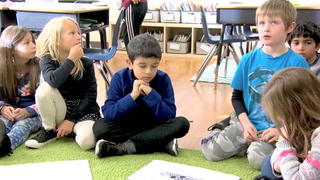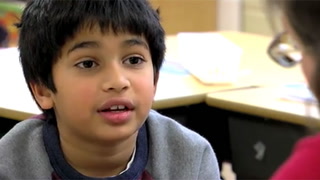Model-Based Claims, Evidence & Reasoning Transcript
Card:
Tch
TeachingChannel
+++ 00:00:03 +++
Kitten Vaa: We have been investigating the town of Mockton and we've been wondering what caused the town to flood. Yesterday, you were collecting some evidence and thinking about that. We have a tool with a model of showing how the water's flowing. And today as a science community, you guys are going to talk about your claim and your thinking and so--
Card:
Tools to support Model-based
Claims, Evidence and Reasoning
Lower Third:
Jessica Thompson
Professor of Science Education
University of Washington, Seattle, WA
+++ 00:00:33 +++
Jessica Thompson: Claims, evidence and reasoning is a kind of talk that teachers are pretty familiar with about supporting kids in classrooms. We are trying to show a different version other than just CER. What is model-based CER? How do you root claims inside of a model? They're usually modeling and argumentation together, and in that way these practices co-develop where they get to get better at scientific modeling and drawing what they can and seeing what they can't see, along with developing much richer scientific claims over time.
+++ 00:01:05 +++
Student: But didn't Miss Moss say that the water can't just go in one way, it has to spread?
Student: Mm-hmm.
+++ 00:01:10 +++
Jessica Thompson: What we've seen in our research is that the number one way to support ideas in traveling is through tools. And so the kinds of tools that Kitten was using today, she had a model scaffold. She had lots of sentence stems. Those are all pieces that support a particular kind of talk.
+++ 00:01:30 +++
Student: Like, we're working on spaces too. It can go through the spaces from here and go--
Student: Then it always has to, like, stop someplace too. It can't just, like, keep going.
Lower Third:
Kitten Vaa
2nd Grade Teacher
Brighton School, Mountlake Terrace, WA
+++ 00:01:42 +++
Kitten Vaa: We started doing some zoom-in models. So we started zooming in on a part of the initial model. We wanted students to start focusing more on the glacial moraine, and so we started, we did another type of model that zoomed in on just on the mountain that was next to the town to help support their thinking about what was going on next to the dam.
+++ 00:02:03 +++
Student: Well, it can also squeeze through stuff.
Student: Yeah. I was looking at the .
+++ 00:02:09 +++
Kitten Vaa: We had sentence stems that were helping in how to talk about their ideas. Those were within partner talk and within classroom discussions and in helping them create their arguments as well.
+++ 00:02:23 +++
Kitten Vaa: They want you to add a "because." This is a why question today. So your sentence will be a because sentence. So this is a because question today of why the water whips. It's not just where it went and what it did. Today it's going-- We're pushing you a little bit more to think about why did that happen.
+++ 00:02:47 +++
Kitten Vaa: What if this mountain was mostly made out of maybe just pebbles or mostly made out of mainly just sand? So we've done some experiments to help us understand how water flows through some of these materials. And now we're thinking about this claim, if we can create a claim, and thinking about if the glacier left mostly some kind of this material, then the water can go faster or slower to the town, so--
+++ 00:03:15 +++
Kitten Vaa: If-then statements help students understand that there's a cause and effect. And in thinking about different conditions, it helps them explain that there's lots of different science ideas that could be happening to explain a phenomena. And so they're thinking about a specific condition that could happen and that that's the cause.
+++ 00:03:37 +++
Student: We decided this one.
Kitten Vaa: So if the glacier left.
Students: Mostly sand--
Student: And then pebbles in the mountain.
Student: And then some pebbles. Because, like--
Kitten Vaa: Then, so what's happening if it leaves mostly?
Student: There's a hole in the mountain and the water's going through the sand. It's like soaking, so it probably takes a long time.
+++ 00:03:59 +++
Kitten Vaa: So are you choosing about then the water can go faster or slower to the town because? Or are you going to talk about the more or less water can go to the town because?
Student: This one.
Kitten Vaa: So you're going to say?
Student: Then the water can go fast or slower.
Kitten Vaa: Fast?
Student: Slower.
Kitten Vaa: Which one?
Student: Fast. Slower.
Student: They're going to do slower.
Kitten Vaa: Slower. To the town because--
Student: To the town because.
Kitten Vaa: So that's what I want you to be adding on there.
+++ 00:04:32 +++
Kitten Vaa: How do we know that? So I know this because this or something, an activity that we've done or some reading that would help support this idea. Because remember, we're talking about a claim is an answer to a scientific question in order to convince other scientists. So this is your claim and now we need to convince the other scientists some of the evidence that we've collected.
+++ 00:04:53 +++
Students: I know this because the sand went slower than the soil. The time of the sand is 52 seconds and the soil was faster.
+++ 00:05:11 +++
Jessica Thompson: They make claims at the beginning of a unit and then they constantly revise them over time. And they're amounting evidence and weighing evidence throughout the entire unit. But it's all done within the drawing of a scientific model.
+++ 00:05:24 +++
Jessica Thompson: We're working on scientific modeling and argumentation K2. With all of these tools and scaffolds we can support reasoning in very young children. Kids naturally are curious. They ask wonderful questions. They ask five whys. We are now just making our instruction match the best of what they're capable of, and when we do that at the early age, we're going to be floored at what they're capable of by the time they get to high school.
+++ 00:05:52 +++
Student: They thought it was going very lightly but it went a lot.
Student: Yeah.
Card:
Tch
TeachingChannel














1 Comment
Terry Wilson Nov 3, 2017 10:50am